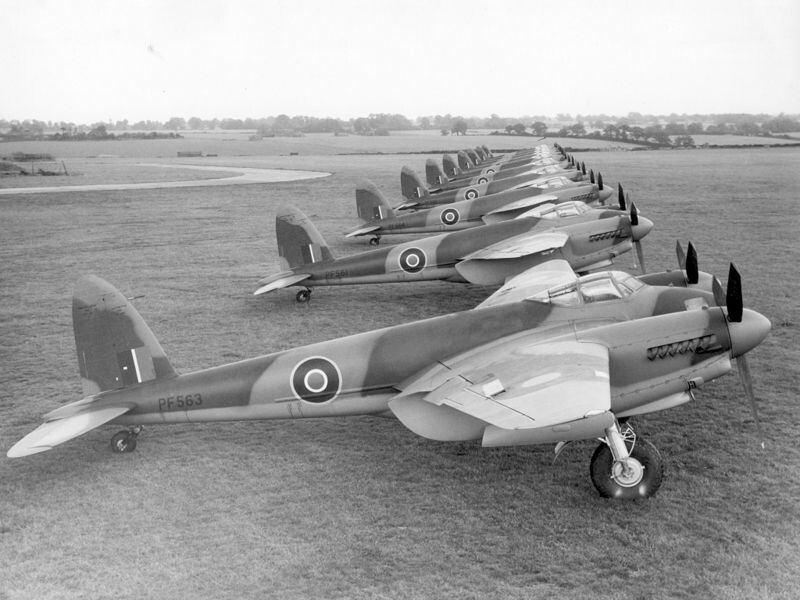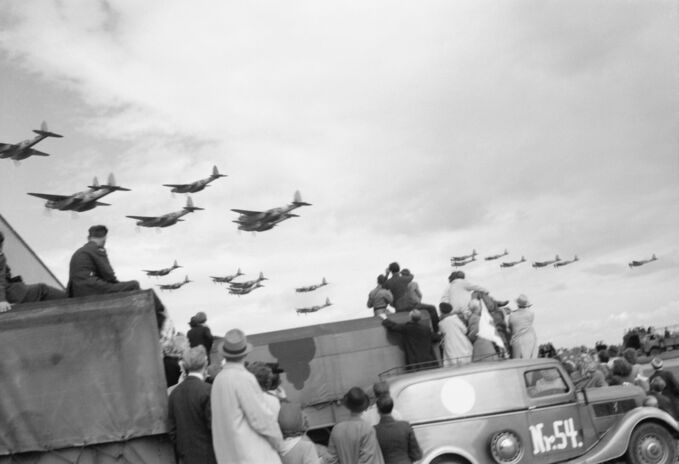The story of the Mosquito begins with the founding of Geoffrey de Havilland’s aircraft company which bore his namesake, de Havilland. Around 1908, de Havilland designed his first aeronautical engine, which he then used to power his first aircraft — a small biplane. In 1920, when the aircraft company he worked for — Airco — shut down, he was able to create his own company, de Havilland Aircraft Company Limited, more commonly known as de Havilland.
Development history:
The de Havilland company was quite unique in its aircraft designs, as it produced several extremely fast aircraft which all had the unique trait of being made of wood. De Havilland’s competitors considered this to be hallmarks of an 'obsolete' design ethos, due to the inherent lack of durability of wood, but de Havilland brushed off these concerns and forged ahead. In 1934, he created the DH.88 'Comet', which won the MacRobertson air race. In 1936, the British Air Ministry created Specification P.13/36 of 1936, which called for a medium bomber of high range and speed — which unfortunately went nowhere and was a waste of both time and money. In response to this failure, however, the ministry created the B.9/38 specification which eventually led to the successful Armstrong Whitworth Albemarle medium bomber. De Havilland took note of this newfound interest by the ministry in fast bombers, which led him to start sketching up a design constructed of lightweight wood and powered by two powerful Merlin engines. And thus, the Mosquito as we now know it today came into existence.
Specifications and operational history:
The Mosquito was powered by two Merlin engines, each with a two-speed, two-stage supercharger that produced a whopping 3,000 HP total at altitude. This extreme power, nestled inside such a light and aerodynamic airframe, granted the aircraft extreme speed and power — giving later Mosquito variants a top speed of 670 km/h at an altitude of 8500 meters.
Contrary to what its all-wood construction might suggest, the Mosquito had a surprisingly high rate of survivability, with very few combat losses. It has a very good reported K/D ratio — almost 10 to 1 — especially given the fact it was fighting far more dedicated air superiority fighter designs such as the Fw-190.
It is important to keep in mind that K/D ratios were prone to over-reporting, political reasons, simple human error (several pilots reporting the same kill), or even pilots just lying for posterity during the war. This number, although possibly exaggerated, is still quite good for the time.
As will be described in more detail later in the article, Mosquitos frequently bombed Berlin. However, they did not simply bomb Berlin: they went in, day-in and day-out, repeatedly bombing Berlin. This earned them the moniker of “Berlin Express” (which is not to be confused with various planes of the same name, or the drama film from the '40s!) They dropped the 4000 lb “Cookie” bomb, also known as a “Blockbuster”.
This bomb is actually where the term “Blockbuster” originated, as it referred to a bomb which could destroy a city block.
Another example of a raid performed by this airframe was the raid on the day of the tenth anniversary of the Third Reich. The Germans were planning a day of celebrations and speeches for January 30, 1943, but their hopes were dashed when the radio suddenly cut out. The Mosquitos destroyed radio communications equipment throughout Berlin, letting Britain turn a day of celebration for the Reich into a fine example of counter-propaganda. They also started the raid at the exact moment Hermann Goring’s speech was to begin, greatly annoying him and prompting the quote later on in this article.
Despite several production delays and exhaustive man-hours of effort being necessary to iron out its flaws, starting from 1941 Mosquitos began to roll out of production lines in large numbers, lending a helping hand to the Allied war machine. The Mosquito immediately became notable, as it was the world’s fastest operational aircraft — not only as a bomber, but as a bomber made of wood. The first Mosquitos were unarmed, contrary to the Mosquito we know in War Thunder, initially being used in the recon and medium bombing roles for most of its production.
Although the Mosquitos were good at bombing — they even launched attacks on Berlin itself in 1943 — it was discovered that they could be adapted as successful night fighters: the Mosquito was fast, the Mosquito could carry a heavy load far, and, most importantly, the Mosquito was made of wood, which has a lesser radio signature than metals like aluminum. And so, in 1941, several Mosquitos were modified to hold less bombs, in exchange for being armed with four Hispano-Suiza 20mm cannons and four 7.7mm Browning machine guns. It proved to be a capable fighter, and lessons learned were later used to design the de Havilland Hornet.
The Mosquito had quite an effect on aircraft design, with de Havilland attempting to emulate the success of it in future aircraft as well. Also to note is the fact that there was a German aircraft of similar size and construction to the Mosquito, known as the Ta 154, but I personally believe that this is more a case of convergent evolution. If you look at the two airframes, you’ll see far more differences than similarities.
Variants:
Amidst the Mosquito’s varied duties, reconnaissance was one of its notable roles. The reconnaissance variants were given enlarged fuel tanks, stripped of their armament, and had cameras mounted to them, which led to a much slower airframe than its brothers in exchange for the ability to provide the recon needed for many Allied raids and operations.
While fighters patrolled the skies and bombers raided cities during World War 2, strike fighters were only a concept at the time. In 1942, the first strike variant of the Mosquito took to the skies, slightly slower and less agile than its predecessors, though being able to carry two 250 or 500 pound bombs in its bomb bay. The strike variant proved successful, proceeding with several pinpoint strikes from 1943 to 1945.
Several variants of the Mosquito tested new equipment, with 18 Mosquitos being built as “Tsetse” variants, with a 57mm cannon installed in the fuselage in exchange for lowered secondary armament and a tremendous loss of speed. Several Sea Mosquitos were built as torpedo bombers, providing the Fleet Air Arm with needed reinforcement.
As the Mosquito had so many variants, an exhaustive list of them would be nigh impossible to present here. The most notable variants of it are listed below:
| Designation | Overall variant type | First flight | Armament | Is it in War Thunder? |
| W4050 | Prototype | 25 November 1940 | Presumably none | No |
| W4052 | Fighter prototype | 15 May 1941 | 4×7.7mm Browning machine guns and 4×20mm cannon | No |
| W4051 | Recon prototype | 10 June 1941 | None | No |
| F.II | Fighter | Unknown, likely during 1941 | 4×7.7mm Browning machine guns and 4×20mm cannon | No |
| FB.XVIII | Strike fighter/fighter-bomber | 1 June 1942 | 4×7.7mm Browning machine guns and 1×57mm Molins Class M cannon | Yes |
| FB.IV | Strike fighter/fighter-bomber | 20 October 1942 | 4×7.7mm Browning machine guns and 4×20mm cannon | Yes |
| FB.26 (Many sent to China after war ending, but built in Canada.) | Strike fighter/fighter-bomber | Unknown, likely during late 1942 | 4×7.7mm Browning machine guns and 4×20mm cannon | Yes |
Summary:
In summary, the Mosquito was a swift, albeit somewhat fragile airframe. While it didn’t have the visible impact of the B-17 or Lancaster, it was still a major part of the air war. With its wooden construction, it was both fast and nearly invisible to early radar, although even LMGs could shoot one down with a lucky hit. For the time, it was quite a unique and effective airframe.
The following is my opinion:
The Mosquito airframe, in my opinion, is an example of why specialist builds rarely survive in nature (or the air war, in this case) when it changes, but become extremely effective in the role they pursue. Sure, a Mosquito could die to practically a cough, but if a pilot flew correctly, they wouldn’t get a chance.
Also, it was a FINE chance for British humor:
It makes me furious when I see the Mosquito. I turn green and yellow with envy. The British, who can afford aluminum better than we can, knock together a beautiful wooden aircraft that every piano factory over there is building, and they give it a speed which they have now increased yet again. What do you make of that? There is nothing the British do not have. They have the geniuses and we have the nincompoops. After the war is over I’m going to buy a British radio set — then at least I’ll own something that has always worked.
Further reading:
- De Havilland Canada’s website: https://dehavilland.com/about/#history.
- Warbird Registry: https://warbirdregistry.org/mossieregistry/mossieregistry.html
Sources:
- Mossie.org: https://www.mossie.org/Mosquito.html.
- Warbird Registry: https://warbirdregistry.org/mossieregistry/mossieregistry.html (All of the photographs are from here).
- Jane’s All the World’s Aircraft 1998.


